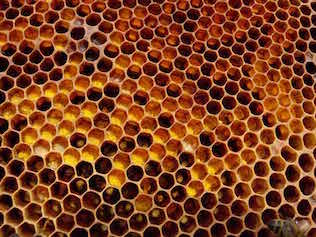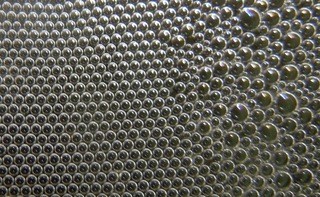You can barely find someone not amazed by honeycombs: a packing of seemingly perfect hexagons. Honeycomb is a cellular network. In fact, they are many similar structures in nature resembling the honeycomb. Although, most naturally occurring cellular networks are not as ordered as honeycomb. But it’s not hard to notice in the image (top left corner), even in honeycomb there are a few cells with 5 neighbors instead of 6.

Honeycomb, a cellular material
Partitioning any surface or volume into closed cells results in a “cellular network”. Examples are soap foam, grains, biological tissues, crack networks, ecological territories, and Voronoi tessellations. It is amazing how very distinct processes lead to cellular networks which are topologically the same. The following image shows bubbles as a cellular network where an interface separates order-disorder phases. If you look at the disordered phase carefully, you will notice that large bubbles are surrounded by small bubbles. This is no accident! This tendency of smaller and larger rings being adjacent is called “Aboav-Weaire” law.

A foam with interface order-disorder
According to the law, average size of cells $m(n)$ around a cell with $n$ sides is:
$$ m(n) = A+\frac{B}{n} $$
$A$ and $B$ are two constants determined for each specific network. This is not an exact equation but works very well!
My interest in cellular networks comes from network glasses. Although in glass science, they are often called random network instead of cellular network and cells are called “rings”. Network glasses are very important networks since they are microscopic and interactions are vert different from commonly studied random networks. But the issue is, rings in bulk glasses (which are 3D) are hard to observe or even define uniquely.
The breakthrough happened only recently. Researchers have been able to image a bilayer silica (SiO${}_{2}$) showing, for the very first time, how atoms are arranged to make the network of polygons creating the ring structure of the glass. Another example of these thin materials is amorphous graphene. Although people have studied glasses for years, the issue is their structure is disordered (and there are $~10^{23}$ atoms to image!), so experimental methods used in crystallography (like x-ray) can’t determine the structure uniquely. This leaves a lot of room for scientific speculations.
Note how different these materials are, ranging from atomic scale to
Although my research is mainly concerned with fundamental aspects of cellular materials but they also have wide applications. These materials are low density (lightweight) and are suitable to make boats, airplane and our bones.
[1] Sadjadi M, Thorpe MF. Ring correlations in random networks. Physical Review E. 2016 Dec 9;94(6):062304. arXiv:1607.06568; DOI (2016).